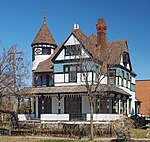Ventura Village, Minneapolis
Neighborhoods in Minneapolis

Ventura Village is a neighborhood within the Phillips community in Minneapolis. Its boundaries are Interstate 35W to the west, Interstate 94 (including the I-94/I-35W bottleneck) to the north, and Hiawatha Avenue to the east. The southern boundary runs (from west to east) along East 22nd Street from I-35W to Chicago Avenue, along East 24th Street from Chicago Avenue to 17th Avenue South, and then back up to 22nd Street from 17th Avenue to Hiawatha Avenue (this portion is only about a block long). Franklin Avenue, which runs east-west, acts as the main commercial artery in the neighborhood.
Excerpt from the Wikipedia article Ventura Village, Minneapolis (License: CC BY-SA 3.0, Authors, Images).Ventura Village, Minneapolis
11th Avenue South, Minneapolis Phillips
Geographical coordinates (GPS) Address Nearby Places Show on map
Geographical coordinates (GPS)
| Latitude | Longitude |
|---|---|
| N 44.9617 ° | E -93.2579 ° |
Address
11th Avenue South 2101
55404 Minneapolis, Phillips
Minnesota, United States
Open on Google Maps







